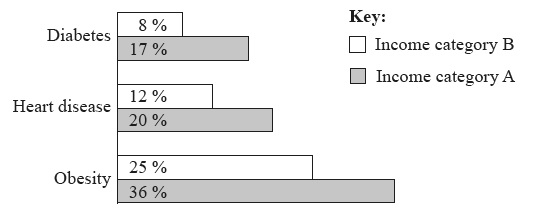| Date | November 2013 | Marks available | 4 | Reference code | 13N.2.hl.11 |
| Level | HL only | Paper | 2 | Time zone | |
| Command term | State | Question number | 11 | Adapted from | N/A |
Question
The graph shows the percentages of people, aged 55 to 64, experiencing three major health-related conditions in a developed country.

[Source: J Banks, M Marmot, Z Oldfield, JP Smith, New Scientist, 17 July 2010. Original data from the Journal of the American Medical Association (JAMA), “Disease and disadvantage in the United States and in England,” 295(17): pages 2037–2045, 3 May 2006]
(i) State which income category is likely to represent the wealthier individuals in this country, and justify your choice.
(ii) State which of the three health conditions shown on the graph is most related to income category, and justify your choice.
Using examples of diseases, distinguish between diseases of affluence and diseases of poverty.
To what extent was one recent named famine caused by crop failure?
Markscheme
(i) B [1 mark].
Because fewer suffer from each of the three conditions, incidence of which is related to access to education/access to health services/lifestyle (accept any of these, or other valid statement) [1 mark] (and therefore to relative poverty).
Accept A [1 mark] and, if justified [1 mark].
(ii) Diabetes [1 mark].
Since its (relative) rate more than doubles from Category A to B [1 mark] (whereas the other conditions increase, but by less than 100%).
Diseases of affluence are those diseases such as degenerative diseases that are associated with different lifestyles and/or increased overall life expectancy [1 mark] typical of wealthy societies. They include coronary heart disease, cancer, asthma, type 2 diabetes, peripheral vascular disease, obesity, hypertension, some allergies.
Diseases of poverty tend to be infectious diseases resulting in lower life expectancy, and associated with poor public health and access to medical services [1 mark], or malnutrition and poor female education (alternative route to this [1 mark]). They include malaria, tuberculosis, AIDS, measles, pneumonia, and diarrheal diseases.
Award the remaining [4 marks] for applied use of examples that distinguish between the two types either according to geographical distribution, or how they are acquired or transmitted.
Award [6 marks] only if the distinction between the two types is fully explicit.
Famines usually result from the interaction of a variety of factors including not only physical factors (for example, adverse climate, soil failure) but also demographic (for example, rapidly expanding population), economic (lack of resources) and political (for example, war zones, refugees), among others.
Stronger responses are expected to look at one example of a recent famine and display some understanding of the different factors involved in causing it to occur/develop. Crop failure need not be a significant factor for the chosen example and full credit is available for answers that mainly focus on the role of alternative factors.
Responses that do not focus primarily on a specific recent famine are unlikely to progress beyond band D.
Responses that look at the combination of causes that led to a specific famine occurring, and then draw some conclusion about the relative importance of crop failure, are likely to access band E.
For band F expect the above with a well balanced attempt at evaluation.
Marks should be allocated according to the markbands.

